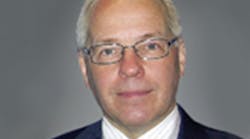The Internet of Things is growing rapidly, with 127 additional devices connected to the Internet each second. That figure comes from David Evans, the former chief futurist at Cisco and current CTO and cofounder of Stringify, an IOT startup, writing in a special issue of Politico dedicated to IoT topics. The fact that the political affairs publication is devoting so much space to the topic suggests governmental officials are ready to get involved in everything from connected cows to the networked battlefield.
Or perhaps not. As Politico’s Darren Samuelsohn reports, 13 members of Congress have come together to form an Internet of Things Caucus, launched in part by Rep. Suzan DelBene, a Washington Democrat and a former Microsoft employee. Unfortunately, the caucus has yet to meet. Samuelsohn quotes Rep. Darrell Issa, a California Republican and cofounder of the caucus, as saying few of the 435 members of the House and 100 members of the Senate even know what the IoT is.
But that may be just as well, as the question remains, should the government be involved in regulating the IoT at all?
In an attempt to address that question, Samuelsohn looks back to 1869 and the completion of the first transcontinental railroad. That technology drove economic growth but also resulted in monopolies and complaints of corruption. Consequently, Samuelsohn writes, Congress created the first U.S. regulatory agency—the Interstate Commerce Commission. Other agencies followed, including the Food and Drug Administration and the Federal Aviation Administration.
The IoT is too diverse to be regulated by such a single agency, but agencies already in existence are having roles to play. Consider the National Highway Traffic Safety Administration, which already is getting involved in vehicle-to-vehicle communications initiatives. Rachael King in the Wall Street Journal reports that NHTSA will propose a connected-car rule by yearend with the goal of getting V2V-capable cars on the road in the early 2020s. She notes that automakers are already at work on a public key infrastructure, which would let two vehicles with no pre-existing relationship securely exchange data. But King also notes that PKI isn’t infallible, with failures having led to the hacking of consumer credit-card and related information. And for V2V applications, such a system would need to scale to 200 million or more vehicles.
As for what could go wrong, she quotes Steven Shladover, a program manager for California Partners for Advanced Transportation Technology, as citing one scenario: “A terrorist might want to shut down a major bridge or tunnel in a major urban area by causing a whole bunch of vehicles to misbehave.”
And automakers aren’t waiting for government to act. King reports that companies including Ford Motor, General Motors, Nissan Motor, Mazda Motor, Honda Motor, Volkswagen, Daimler AG’s Mercedes-Benz, and Hyundai Motor have come together to form the Crash Avoidance Metrics Partnership (CAMP) consortium to research and test various security approaches.
Indeed, as regulatory issues get worked out, it behooves private industry and even individuals to be mindful of safety, privacy, and security issues. MIT professor Sanjay Sarma, also writing in the Politico special issue, recounts how he, an IoT pioneer, populated his house with dozens of connected switches, motion detectors, and thermostats to enable control of lighting and heating. His last step in the project? He killed it. “I realized that anyone could plug into the outlet on my deck and take control of my house,” he writes.
Nevertheless, he writes that he remains optimistic about the IoT and that security issues can be addressed—possibly through a “cloud of things” that is easy to update in response to new threats. He does see a role for government and urges policymakers to not just assume that IoT problems will work themselves out.
Rick Nelson, Executive Editor
Visit my blog: www.evaluationengineering.com/ricks-blog/

